3 December, 1999
Life at Field Camp
Many of you have written to ask about the living conditions at field
camp. The camp at Lake Bonney, like many other field camps, is quite
comfortable. We have a heated Jamesway, so it's rare to be cold once
you're inside. In fact, sometimes is gets so warm we wear short-sleeved
t-shirts inside. Unlike more extreme situations where researchers work,
cook and sleep in their tents, this is rather plush living. It's sort of
like car camping without the car- we've got most of the comforts of home.

This is the main entrance to the Jamesway at Lake Bonney. There's a small storage vestibule inside where we keep our cold weather gear and assorted odds and ends. I'm getting ready to put on my crampons before going out on the lake.
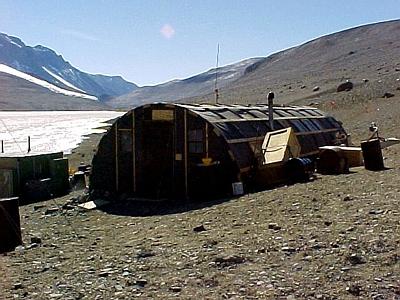
The back of the Jamesway faces the outhouse. It's close enough to get to without having to put on all our gear. (Look for the outhouse- it will be featured in a later journal entry.)
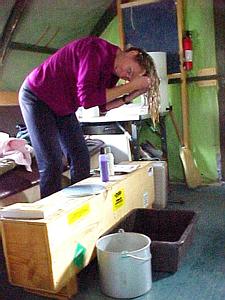
Before anyone pulled out our fancy shower, Barb resorted to washing her hair over a dish pan.
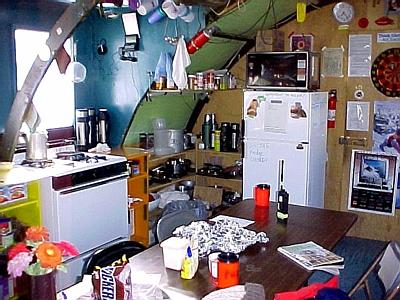
An inside view. Things have been accumulating in here for easily the last ten years. From this vantage point, you can see almost half of the entire space. With twelve people, it gets very crowded. That's why everyone appreciates having their own tent. The appliances (refrigerator and stove) are run by propane, which is stored in canisters outside.
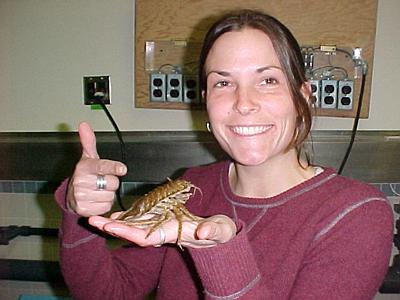
Sarah Riseman came along as Jack Di Tullio's research assistant. She recently finished her Master's degree at The University of Charleston where she studied isopods. This photo was taken in the Crary lab at McMurdo. The isopod was collected in McMurdo Sound. We don't have any animals you can see without a microscope living in Lake Bonney.
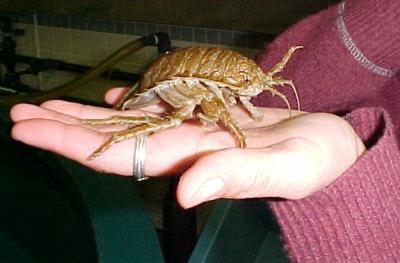
Iosopods, like crabs, are crustations. They inhabit niches in salt and fresh water and on land. Marine isopods like this are related to the terrestrial (land-living) pill bugs and potato bugs you may find around your house or garden. They can make their living in a variety of ways. They can be predators, scavengers, detritivors (animals that eat parcticles off the sediment or the surface of plants), or herbivores that eat algae. The one in this picture is called Glyptonotus antarcticus, or the Giant Isopod. It's an opportunistic feeder that will eat everything from brittle stars to sea spiders to polychaete worms- they'll even resort to eating algae. This one crawled into a fish trap to feed on the bait and got pulled up from a depth of over eighteen hundred feet in McMurdo Sound. It's large for an isopod- about 5 inches long. The two specimens we took photos of will be returned to the sound.
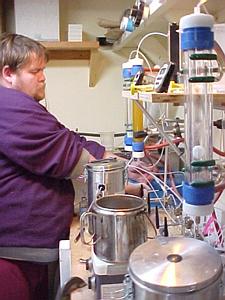
Peter Lee, another team member, is a native of the north island of New Zealand. He's a chemical oceanographer who just finished his PhD, and is doing the project's analytical chemistry work. He's also an enthusiastic rugby player. He recently moved to Bozeman to do postdoctoral work with John Priscu.

I caught Jack before he had a chance to spit his toothpaste down the drain.

Here's the shower I mentioned earlier. John P. is demonstrating how it's done. The shower curtain is inflated to wrap around him and is held up by a pulley that's attached to the ceiling. First he heated water on the stove. Next, he filled the solar shower bag with a couple of gallons of warm water. Then, he stood in two dish pans- one for each foot, and scrubbed away a week's worth of grime. When he finished, he collected all the water and placed it in the graywater barrel to be shipped back to McMurdo.
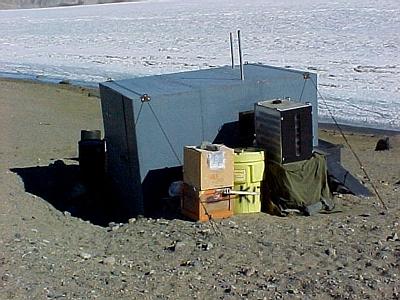
This shed houses the generator- the noisy source of all our power. Unless you are inside it, the racket generally fades into the background, especially if you're inside the hut and there's music playing. Since I'm usually up long after the generator is turned off at night, I often get the chance to experience a fine dose of concentrated silence as I head off to my tent.

We have three tiny 6'x10' labs at Lake Bonney. The closest is the filtering lab, where Sarah and Jack process all our water samples and set up experiments. The chemistry lab in the middle is where Peter spends most of his time running the gas chromatograph to identify sulfur compounds in the lake water. John L. does most of his virus and bacteria work with radioactive compounds in the third lab.
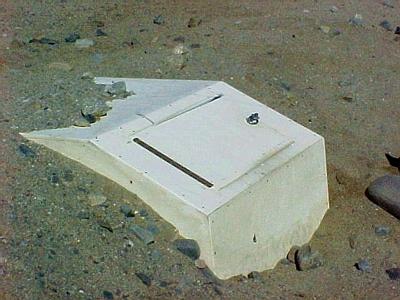
We have much more food that needs refrigeration than we can keep in the small freezer section of our refrigerator. This is an underground storage area, dug into the side of the slope. It's similar to an old-fashioned root cellar.
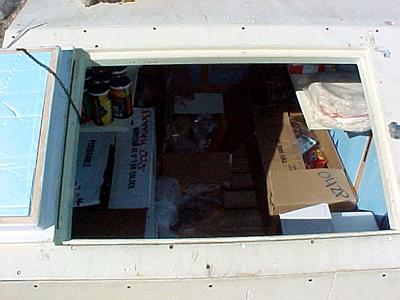
In addition to being set below the permafrost level, the interior of the cold food storage is insulated with foam. There's not a lot of room to move around inside, so we organize items by category to make it easy to locate what we want without having to do much searching.

Running a camp for a season requires large quantities of fuel. The black barrels are stocked with fuel for the generator, vehicles and drills. The barrels are set on plastic and are surrounded by yellow booms. This is to catch any fuel that might leak out. There are two types of silver canisters in the foreground. The numerous bullet-shaped containers are full of propane, and the one in the center holds liquid nitrogen which is used in the gas chromatograph.

It's difficult to anchor tents here due to the sandy soil. My tent has four huge metal stakes holding down the corners, and all the guy lines are tied with trucker's hitches to piles of rocks. Sometimes when the wind is howling through the nylon when I'm trying to sleep, I worry the rocks will start to catapult through the sides of my tent. In those moments, I pull my fleece liner and bag way up over my head in the futile hope of cushioning the blow.

Craig is attaching a sling load to a helicopter as it hovers overhead. This shot was difficult to get due to all the sand the rotors kicked up. You never want to approach a helicopter at Lake Bonney without wearing eye protection.
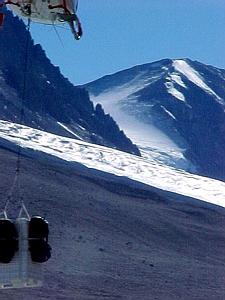
The load on its way to the camp at Lake Hoare.
Contact the TEA in the field at
.
If you cannot connect through your browser, copy the
TEA's e-mail address in the "To:" line of
your favorite e-mail package.
|
